Prospective destroyer for the Russian Navy - let's fantasize?
“The construction of the new generation’s leading destroyer ocean-going destroyer squadron will begin in Russia in 2012,” said the Chief of the Naval Fleet Admiral Vladimir Vysotsky. According to him, until now, surface ships of the coastal and marine zones of the Corvette and Frigate type were being built in Russia, and ships of the ocean zone were not built.
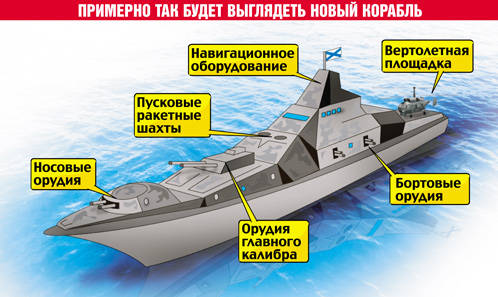
"The construction of a new destroyer can be started in the 2012 year," said Vysotsky. Earlier, the commander-in-chief reported that a new destroyer-type destroyer of the ocean zone would be created in metal in 2016 for the country's Navy. At the same time, he emphasized that the nuclear power plant will be installed on this ship. ”Http://www.dni.ru/society/2011/7/29/216342.html
Why is joy relative? Exclusively because the postponement of the construction of warships for our Navy for a year, five, or even “after a rain on Thursday, when cancer hangs on the mountain,” has long become habitual.
And the source of information, to be honest ... not that the ultimate truth. I remember that our commander-in-chief of the Navy in 2008 r promised to build as many 5 multipurpose aircraft carriers. And where are they? The plans of the domestic shipbuilding to 2020 g their tab is not provided.
In addition to healthy skepticism to the words of Vysotsky, there are other reasons for doubt. Here is what they wrote about our promising destroyers in March 2010 http://www.vz.ru/news/2010/3/11/382823.html
“The development of a new generation destroyer for the Russian Navy has begun, which will be built using stealth technology, a source in the military-industrial complex said on Thursday.
“Now research is being carried out to form the appearance of a new ship in the far sea zone, the technical documentation of the project is being issued. This process will last about 30 months, ”a source told Interfax.
"The destroyer will receive a missile complex weapons with universal vertical launch launchers for firing high-precision missiles at ground, surface and underwater targets. The ship’s air defenses will be provided by long, medium and short range anti-aircraft missiles, ”the expert specified.
The destroyer artillery mounts, which will be able to fire at enemy coastal and sea targets with precision-guided missiles, will also be universal, the military expert added.
The multifunctionality of the ship will have an impact on the content of its electronic filling, the expert noted. ...
... According to him, the ship of the far sea zone will have unlimited seaworthiness and speed to 30 knots. With the 17 hub, the destroyer can autonomously travel up to 10 thousand miles. The crew size is expected to be relatively small, which will improve the quality of habitability. The ship’s displacement will reach 10 thousand tons. The main power plant of the destroyer will be of a gas turbine type. The ship will provide a hangar for two anti-submarine helicopters. "
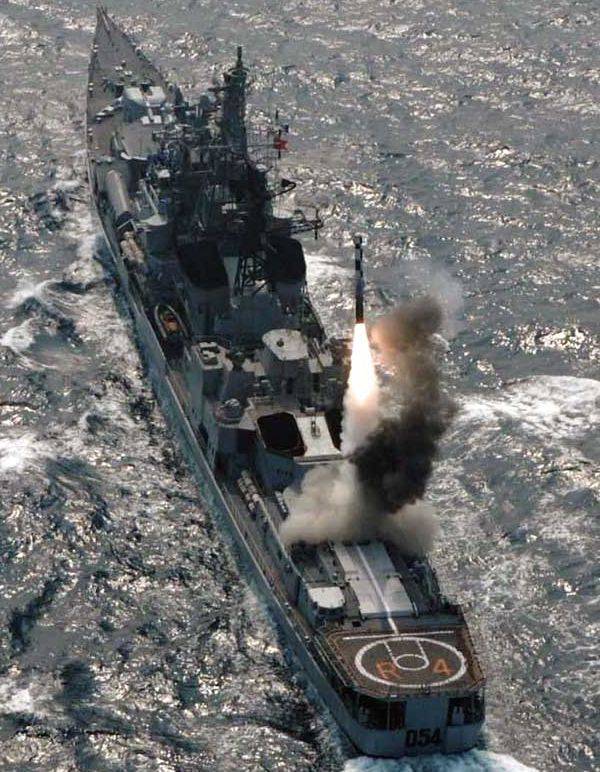
So what do we have? The ship development time in March 2010 g was estimated at more than 30 months, and this is despite the fact that the technical documentation of the project is not at all the same as the working drawings. And most importantly, a ship with a gas turbine installation was designed, and now the commander-in-chief of the Navy is talking about an atomic ship. But after all, it will be a completely different project ... So, the elaboration of the project of the ship to 2012 g to the stage that allows it to be bookmarked is highly questionable.
And yet ... something began to move in the Danish kingdom :))) In principle, I would estimate the likelihood that a new type of ocean ship for the Russian Navy will be incorporated in 2013-2016 approximately as 50 / 50. What will it be, this ship?
Currently, the most advanced project of a promising destroyer of the Russian Federation is, in all likelihood, the Northern PKB 21956 project.
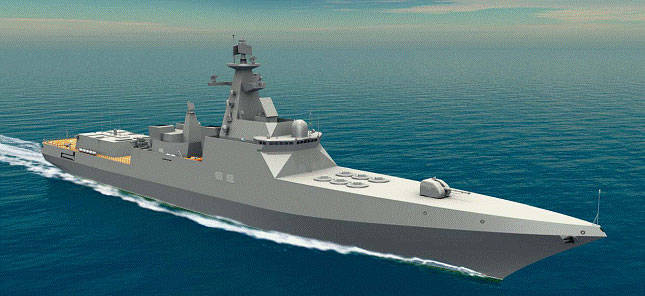
Displacement around 9000 tons (full)
163 length m.
Width m 19,00.
Draft 5,5 m.
Technical data
Power plant power plant
74000 power l. with. (54 420 kW)
29,5 nodes speed
5800 miles sailing range (on 18,5 nodes)
The autonomy of swimming 30 days (for stocks reserves)
Crew ≈300 man
weaponry
Radioelectronic armament of the Frigate and Rif-M radar (surface targets),
Sonar "Zarya-ME-03" (underwater)
Artillery 1 130-mm. AU A-192 or 1х2 AU AK-130
Anti-aircraft artillery 1 MASTER "Chestnut"
Anti-ship armament "Caliber-NKE" (16 PU)
Anti-submarine weapons "Caliber-PLE" 91РЭ1 (91РТЭ2)
Anti-aircraft missile weapons 6 * 8 ZRK "S-300F" (48 ZUR 48H6Е2 or 192 ZUR 9М96Е)
Mine-torpedo armament 2 * 4 torpedo tubes
Aviation group: there is a hangar and helipad
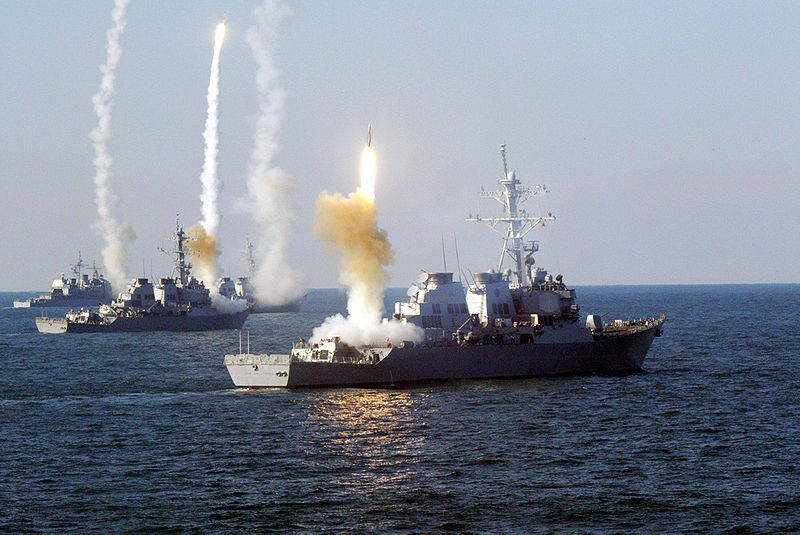
It seems that EM was designed relatively recently - a draft design was first demonstrated in 2007. But who knows - maybe it was still being developed in 90's, and it was only now that they showed it up? But this ship clearly "does not pull" the role of the ruler of the seas. The same “Orly Burke”, having a similar displacement, carries an 2 UVP Mk 41 with an aggregate capacity of 96 cells — in this case, a container carrying one Tomahawk, Asrok, Standard, or 4 “C. Sparrow” can be installed in each cell ".
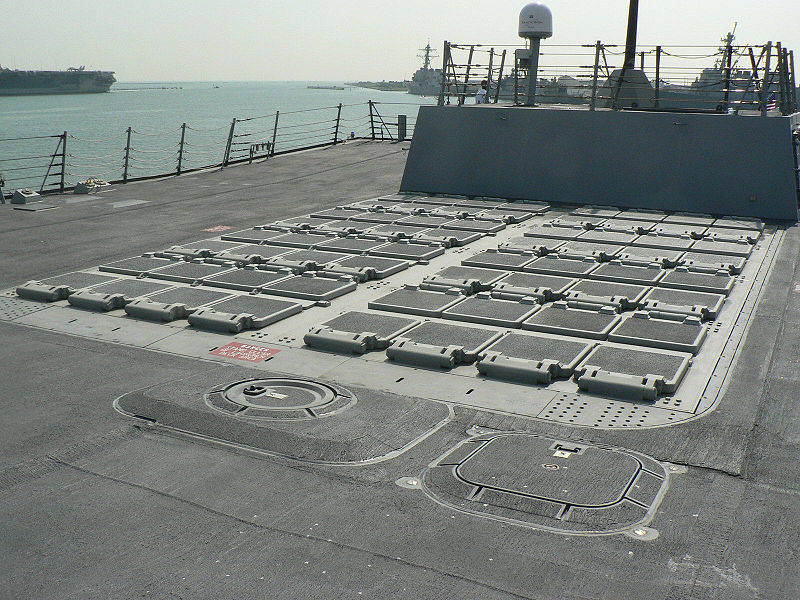
Our ship’s ammunition is the 64 container. But if “Orly Burke” can take absolutely any combination of rockets, then our 21956 destroyer is limited by the fact that it is impossible to install anti-aircraft missiles in the Caliber-NKE installation - just as in C-300F it is impossible to “cram” the anti-ship missiles or PLUR. In addition, the C-300F installation is not UVP in the full sense of the word - unlike the 41 MK, it is a drum rotating below the deck - which, apparently, adversely affects the mass of the installation, and therefore the size of the ammunition set.
The 48H6EX2 SAM is a good rocket, with a reach of up to 30 km and a range of 200 km — but still, by modern standards, this medium-range SAMs. It surpasses its American counterpart "Standard SM-2MR" (24 km and 166 km, respectively), but is slightly inferior to "Standard SM-2ER" (33 and 240 km) and, of course, "Standard SM-3" - having a reach 250 km altitude and 500 km range (although it should be remembered that at specified distances, the SM-3 Standard can only knock down non-maneuverable targets — for example, warheads flying along a ballistic trajectory, and the parameters of this trajectory must be known in advance).
It is worth paying attention to one more sad fact - the C-300F seems to be able to use only the 5В55РМ AUR with a flight range of up to 75 km and an altitude reach of - 25 km. But the 48XX6X2 SAM can be installed on C-300FM (this is exactly what was put on Peter the Great). But the larger size of the missiles has led to the fact that the ammunition reduced by 2 missiles - from 48 to 46. Maybe our project 21956 still supposed C-300FM - but then why 48 missiles, and not 46? If we are talking about C-300F, then it is completely sad.
Based on the foregoing, it can be stated - most likely the promising EM of the Russian Navy is neither the 21956 Ave nor its deep modernization. Its armament no longer fully meets modern requirements, the cruising range is much lower than that stated in the project, power - the GEM, and not the atom. It is possible, of course (and even certain), that when designing a new EM, some developments of the 21956 project will be used - but this will be a completely different ship.
Unfortunately, nothing concrete is known about him. Well, if so - there is a large field for fantasy and folk art, which I will now begin.
How I would like to see a promising destroyer of the Russian Federation
All drawings are taken from here www.otvaga2004.narod.ru THIS IS NOT A PROJECT IMAGE - but just folk art.
Just want to say - my vision of the role and place of EM in the modern navy of the Russian Federation was greatly influenced by the wonderful article by the most honorable colleague 178_ http://alternathistory.org.ua/perspektivnyi-esminets and, even more, by the discussion of this article with its author.
EM is a single type of oceanic missile torpedo-artillery ship. This is a universal warship that combines the capabilities of missile cruisers, destroyers and anti-submarine ships of the Soviet Navy. EM combat systems must be integrated into the CICS, like "Aegis" (only better :))) capable of receiving / transmitting intelligence and target designation from / to any submarine, surface and air combat units of the Russian Navy (including not only ships and manned aircraft, but and unmanned aircraft, missiles, satellites, etc.). The armament of the EM must ensure the reliable defeat of any existing classes and types of aircraft, surface ships and submarines of the potential enemy over a distance exceeding the effective range of their weapon systems. The ship must have developed anti-missile and anti-torpedo defense systems, including electronic warfare, as well as advanced structural protection.
One of the serious shortcomings of the Soviet surface ships was their “anti-ship” orientation, the USSR built its fleet exclusively for the “fleet against the fleet” battles. Modern EM should have greater versatility - it should be able to participate in the actions of the fleet against the coast as a ship-rocket arsenal by attacking sea-to-ground missiles and artillery.
At the present time, it is quite obvious that a squadron that does not have aircraft cover cannot effectively counteract a modern aircraft carrier strike group (AUG). Therefore, the leadership of the Russian Navy fully realized the need for its own aircraft carriers, despite the fact that the shipbuilding program before 2020 does not provide for the laying down of at least one aircraft carrier, there is no doubt that in the future Russia will begin building its own aircraft carrier. At the same time, it was repeatedly said that we would create not classic AUGs, but much more information-integrated connections, in which the aircraft carrier itself, escort ships, submarines, aircraft, satellites, etc. will act in a single information space according to the principle - “sees one - see everyone”. Therefore, promising aircraft carrier connections of the Russian Federation have been called MAS - “marine aircraft carrier system”. Obviously, promising EMs will become one of the components of the MAS.
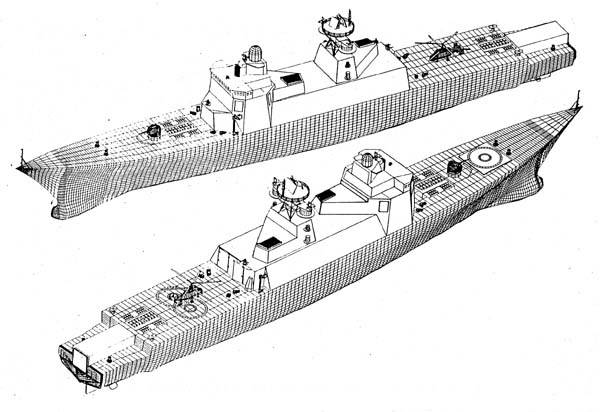
Therefore, the main types of hostilities in which prospective EM RFs can take part will be:
1) As part of the MAS - all types of naval battles, including the most complex - operations to destroy AUG, or a heterogeneous squadron that does not have an aircraft carrier, but is under the protection of coastal-based naval aviation
2) Outside the MAS, operations to destroy disparate squadrons without air cover
3) Striking enemy coastal targets - both as part of the MAS and independently
4) Observing and tracking AUG of a potential enemy during periods of aggravation of the international situation and launching a preemptive strike in the event of a war, both as part of the IAC, and independently.
All of the above allows us to formulate the requirements for arming advanced EM. In determining specific types of weapons, it should be borne in mind that the first destroyer will enter service no earlier than 2017-2020, and serial construction will be carried out in the period from 2020 to 2030. Taking into account the fact that the development of new weapon systems takes from 5 to 12 years, we can not be limited to existing weapons systems. We can also organize the process of developing new missiles, artillery, etc., optimizing their performance characteristics for the most effective solution of EM problems, providing for the possibility of placing existing weapons systems as well as systems that will go into service in the first production ships.
So far, shipborne rocket weapons had a clear specialization - PKR, ZUR, PLUR. But lately there has not yet been a clear tendency in the world - universalization of anti-ship missiles and anti-aircraft missiles (for the time being, this undertaking is being implemented on small missiles, including in the Russian Federation - let’s recall Kornet, which, although not anti-ship missiles, can hit both ground and air targets). On the one hand, the idea seems to be delusional, since the tasks of these missiles are completely different, but on the other hand ... it is as tempting to have a universal rocket to destroy surface and air targets.
Let's compare for starters some TTX "Standard SM-2ER" and "Harpoon RGM-84D2"
Starting weight - 1466 and 742 kg, respectively.
Length - 6,55 m and 5,18 m
Diameter - 0,53 m and 0,34 m
Flight speed - 3,5M and 0,85M
Warhead weight - 113 kg and 235 kg
Flight range - 240 km and 280 km
And now let's look at the same thing, with 48H6X2 AID, Ball-Club 3М-54Е1 and Onyx 3М55
Starting weight - 1900 kg, 1800 kg and 3100 kg
Length - 7,5, 8,22 m and 8,9 m
Diameter - 0,519 m, 0,533 m, 0,7 m
Flight speed - above 7М (2,1 km / s), 0,8М and 2,9М (at height and 2М - at the surface)
Warhead weight - 150kg, 400 kg, 250 kg
Flight range - 200 km, 300km and 300 km (when flying at low altitude - 120 km)
In other words, modern anti-aircraft and anti-ship missiles somehow became very close in terms of mass-dimensional characteristics, and, often, anti-ship missiles have less weight and size than missiles. There are, of course, differences - MUD is faster, has a smaller warhead weight and a shorter (but comparable) range. In the example I have cited, the “Onyx” supersonic anti-ship missile is “apart from ZUR” - but, on the other hand, the new and more long-range ZNXNNXXX48E6 ZNR (range to 3 km) will already have 250 kg of warhead against 180 kg of Onyx. And the starting mass of the new long-range 250Н40Е (range up to 6 km, reachability by height - 400 km), apparently “goes away” for 185 tons.
However, the mass-dimensional characteristics - this is not all. Also important is the flight path of the rocket. In missiles - everything is clear, she simply flies to the aerial target, because no one has yet thought of shooting down missiles with antimissiles. They are counteracted mainly by traps and EW. Quite another thing - PKR. These try to cling to the surface of the sea and not to glow for the time being, until the time on the radar screens. Because the anti-ship missiles, flying at high altitude with speed 0,8 - 2 M is a "legitimate prey" not only for antimissiles but also for conventional missiles.
It is quite another thing - modern Zur, flying with speed 6-7М at high altitude. If, say, the promising 40H6Е can withstand the cruising speed of 2 km / s (its maximum speed is 2,5 km / s), then its flight time to the target located in 250 km from the volley point is slightly more than 2's minutes. The chances that the enemy for the specified 2 minutes can not only detect the missile defense, but also prepare and launch its own missile defense, which also requires a certain time to intercept - at least illusory. That is why it is believed that the hypersonic anti-ship missile system is invulnerable to modern air defense systems. But hypersonic anti-ship missiles exist only on paper for the time being - but hypersonic missiles are already standing "on the wing." Accordingly, missiles capable of flying along a U-shaped trajectory and falling on enemy ships from above and now, and in the coming years, will be a weapon that cannot be reflected otherwise than by means of EW. At the same time, the missile defense system can carry quite a decent warhead, up to 200 kg - of course, this is not the "Granit" with its 750 kg warhead, it is unlikely to drown the enemy aircraft carrier with even several such missiles. But when a cruiser enters the escort ship, inclusive - the mass of “pleasant sensations” is guaranteed, and, most likely, even one such missile attack will destroy the thin electronics of the ship - radar arrays, etc., etc. In this regard, the high-explosive warhead missile defense system is fully justified - it, of course, does not cause such damage as would the RCC, which made the "hill" and hit the enemy ship from above, with its penetrating high-explosive or even semi-armored warhead - but turn the superstructure of the enemy ship and “Dazzle” him - Zur is quite capable. In this case, the enemy ship, even with unused ammunition, will lose its ability to control the surface / air situation and air defense, and therefore will be easy prey to conventional anti-ship missiles.
... But who knows what damage to the modern ship is capable of inflicting a telegraph pole, breaking through the deck at hypersonic speed, and even with a two hundred kilogram warhead? Damage received by relatively modern surface ships ("Stark", "Sheffield") as a result of hits of conventional, subsonic CRPs with much more modest characteristics (both in speed and mass of the rocket and warhead) do not have any optimism. Even one such missile is enough to disable a frigate ship.
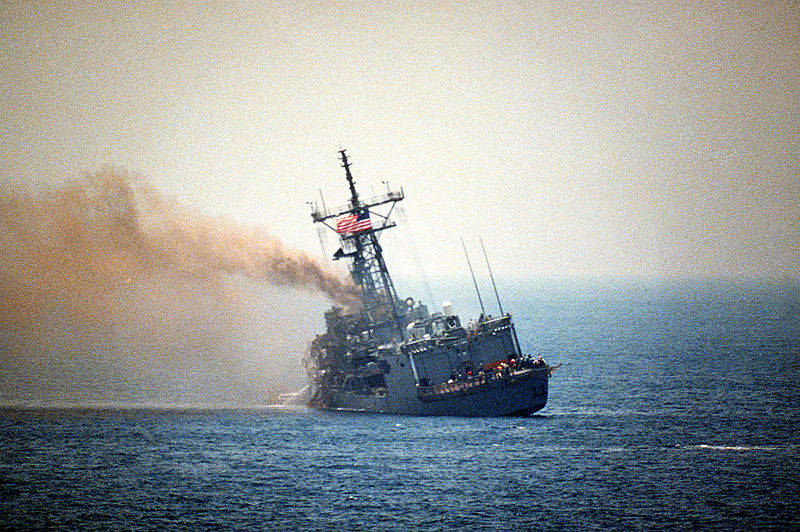
And the most important thing is that there is never a lot on the PKR warships - rarely there is at least an 16 RCC in the ammunition of a modern ship, or even less. At the same time, a guaranteed 100 RCC is required for a guaranteed glut of US AUG air defense. The Soviet fleet for such an attack would need to assemble all 4 nuclear-powered cruisers in one place - but the same effect could have been given ONE ship of the “Orly Burk” type if he were armed with universal missiles.
And this is the second advantage of the universal missiles. Even a pair of modern destroyers with UVN on 70-90 missiles and universal missiles in them are able to reliably repay the air defense of a typical American AUG or even a larger squadron.
But what needs to be done to turn the missile defense system into anti-ship missiles?
The fact is that the homing systems of our missiles and missiles, frankly speaking, are fundamentally different. CRPs use an inertial guidance system on a large flight segment, and only when approaching the estimated location point does the active — the radar guidance system — that is, turn on own radar missiles. At the same time, the SAM (C-300 and C-400) mainly use a semi-active guidance system combined with radio correction - when the SAM system is illuminated by a target indicator radar (i.e. located on a ship or aircraft), and the SAM is guided by the reflected from the target signal of this radar. Obviously, if the enemy is within reach of the radar of a warship, he is quite capable of “planting” missiles at him, but at large distances, outside the radio horizon, such a feat is possible only with external target designation, and this external target designation should act throughout the flight rockets. Yes, it is possible to land an RLD helicopter on a destroyer - but no one guarantees that it will not be picked up at the most crucial moment and, like a deadly volley of missiles, will simply "go into the milk." In this regard, the anti-ship missiles are much more functional, because the combination of inertial and active guidance systems implements the principle of “fired and forgotten” - it can give a volley to the point where enemy ships were found, even if contact with them is lost - the IP will help you not to go astray , and the head of active homing with a high degree of probability will allow her to still find the enemy. Modern missiles are capable of capturing a frigate class target at a distance of up to 40 km and even more, and even subsonic anti-ship missiles will take no more than 200-250 minutes to overcome 15-20 km, in which a ship moving at a speed of 30 nodes will have no more than on 14-16 km.
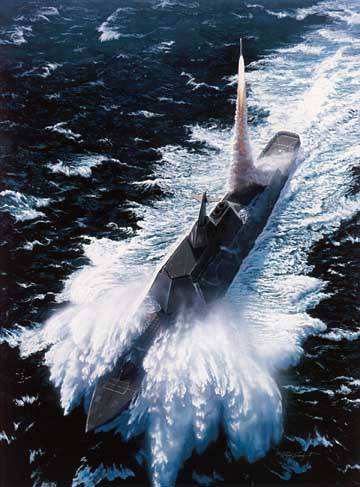
Thus, in order to create a full-fledged SD (universal rocket), it must simultaneously have an inertial, active and semi-active guidance system. How realistic is this?
In principle, this is a solvable problem. For example, the standard-2MR (RIM-66C) missile defense system has a combined guidance system (radio command remote control, inertial and semi-active radar).
As for our missiles, I can only say that you need to add inertial and active to their semi-active guidance systems. How hard is it? The active RLGSN of our Onyx RCC weighs 85 a kilogram. As for inertial systems, the weight of models known to me ranges from 5,4 to 23 kg.
It should be borne in mind that for the Zur RLGSN Onyx has excessive capacity. It guarantees the detection of surface targets at a distance of 50 km - however, for a missile system capable of overcoming 400 km in a couple of minutes, this is not required - during this time the ship, the next 30 knots with speed, will hardly leave 2 km. Although, of course, the more powerful the RLGSN signal is, the better (the more difficult the EW means to suppress).
In other words, overloading the UR will not exceed 100 kg — and, given the improvement of technology and some weakening of the RLGSN, is much less. It is necessary to take into account the fact that, in all likelihood, part of the semi-active homing equipment can simultaneously “serve” and active. But, of course, even a weight gain of several tens of kilograms will significantly increase the launch mass of the rocket - more engine power will be required, a larger fuel supply ... This is certainly a shortage of SD. However, it is necessary to take into account that the combination of active and semi-active seeker in one rocket leads to the appearance of not only shortcomings ...
The fact is that the main protection of aircraft and other aircraft against missiles is the EW systems. How do they work?
When an EW block receives a message about radar exposure (no matter the SAM or carrier from which the SAM was launched), the block determines the frequency at which the radar operates and starts to fade at that frequency, filling it with white noise. In response, the developers of the missiles taught their missiles to change the frequency of the radar - but the EW developers did not remain in debt - they taught their systems to react quickly to changes, monitor them and “fade” exactly on the waves on which the radar is currently running . Thus, one EW unit is able to “blind” one Zour. Moreover, if the missile defense system is equipped with active homing, then the chance of blinding it is quite high, since the RLGSN missile defense and the power of the EW unit have comparable power - but to blind the missile, which has a semi-active homing head, is more difficult because of the power of the EW unit with which Zur is guided. Here everything will depend on the distance from the radar to the EW unit.
But if the SD can simultaneously cut both active and semi-active homing, then in order to blind the SD, you will need not one, but two EW units. Thus, the combination of active and semi-active guidance systems significantly increase the chances of missiles to hit the air target.
Consequently, the creation of a single missile from missiles is not only possible, but also promises significant advantages for such a missile in defeating air targets.
It is these missiles, in my opinion, that should become the main weapon of the promising EM of the Russian Navy.
Approximate TTX of such missiles - weight - up to 2,1 tons, warhead - no less than 180 kg, range - no less than 450 km, average speed - no less than 7 M.
However, armament consisting solely of SD is absolutely insufficient for EM. Yes, a full salvo of the UR two EM ammunition can "kill" the air defense of the classic AUG and, possibly, even sink the tracking ship 1-2, but that's all. In order to destroy an aircraft carrier, you need something more. For these purposes, the EM must have a “main caliber” - several heavy hypersonic anti-ship missiles. The tactics of their application looks like this - they start right after the "shooting" SD. By the time the PKR was approached, most of the enemy’s air defenses were disabled, while the remaining ones had “eyes of divergence” from the abundance of air targets, so there is nothing banal to repel an attack of even a small number of anti-ship missiles.
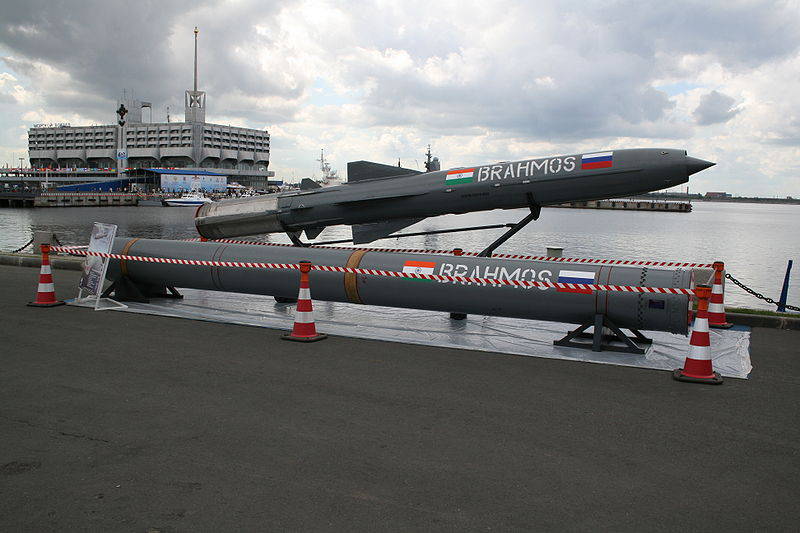
The characteristics of these missiles look like this
Weight - 4,2 t, warhead - at least 450 kg, range - 450 km, average speed - 5-6 M.
The ship’s ammunition should include the 2 DPS, one on the 90 UR, the second on the 8 RCC. Lot?
The total number of launchers - 98 - is quite comparable with the “Orly Burke” (although our missiles are heavier). Let's try to compare the total weight of the main rocket armament for large rocket ships.
“Orly Burke” - the total displacement of 8488 tons, 96 containers, for example - in all the “Standard SM-2ER” - the total mass of missiles - 140,7 tons (per ton of missiles - 54,8 tons of displacement)
“Ticonderoga” - full displacement of 9800 tons, 122 container, for example - also with “Standard SM-2ER” - total weight - almost 179 tons (for 1 tons of missiles - 60,3 tons of displacement)
RKR "Glory" - full displacement - 11 380 tons, 16 "basalts" in 4,8 tons and 64 missiles with a mass of 1,6 tons - total 179,2 tons (in 1 tons of missiles - 63, 5 tons displacement)
The worst figure of "Glory" is due to the fact that the launchers of his missiles are much heavier than those of his American counterpart.
Perspective EM - 90 DL on 2,1 t and 8 RCC on 4,2 t - 226 tons, which roughly corresponds (if we take the Ticonderogu as a model) to the total displacement in 13 425 tons. That, in principle, is acceptable (given the fact that the Zamvolt EM has a full displacement of 14,5 thousand tons).
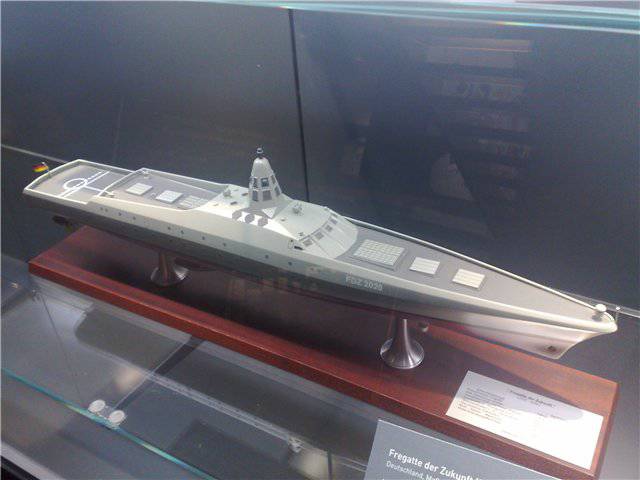
The basis of the missile defense will be missiles, deployed instead of a part of the ammunition of universal missiles. So, at present, the installation “Polymer-Redut” accommodates one long-range missile defense system (48Н6Е2) or 4 9М96Е in a single cell - small ЗРР with a range of 40-50 km. In the future - even smaller 9М100 SAMs - with a range of just 15 km, but on the other hand, 16 of such antimissiles are included in one cell.
Thus, in 90 cells of the universal reconnaissance missile of advanced missiles, promising EMs can carry, say, 80 UR, 20 antimissile missiles of medium-range (up to 50 km) and 80 ultra-small missiles.
In addition to the above, it seems promising to equip the ship with four “Palash” or “Pantsir-M” installations.
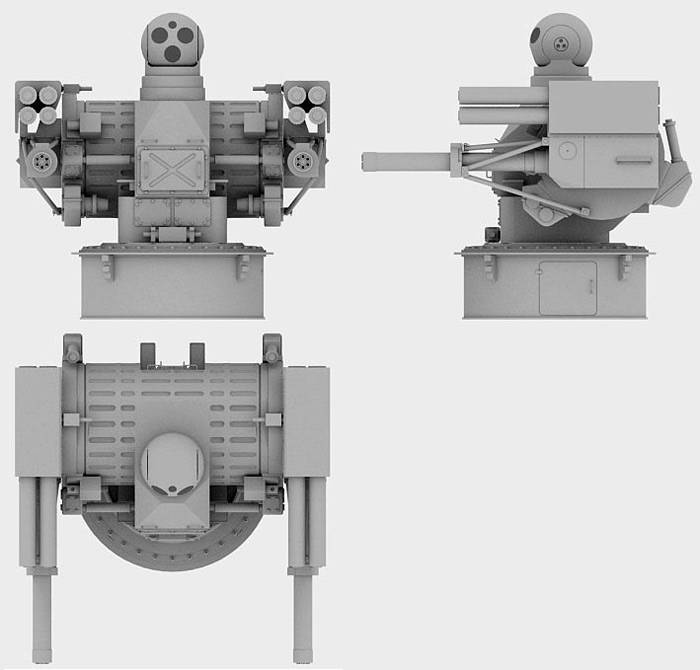
The basis of anti-submarine weapons should be a complex of Medvedka-2, Caliber 91РТЭ2 type rocket-torpedoes or more modern, launched from UVP UR.
Anti-torpedo defense provided by 2х3 installations 324 mm torpedoes
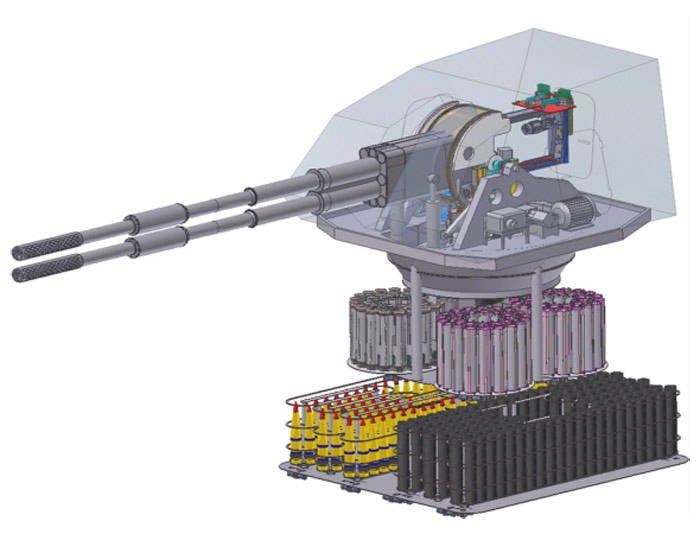
One two-gun installation of the Advanced Coalition-F class. Currently, the installation has the following characteristics
Caliber - 152 mm
Barrel length - more than 52 calibers
Firing range - more than 50 km
Installation Rate - 15-16 rds / min
Ammunition-in the ammunition installation will include advanced guided missiles and special long-range shells (probably active-reactive).
The main direction of improvement is to bring the rate of fire to (minimum) 30 rounds per minute, to bring the range of the active-missile to 100 km.
Power
But from the atomic power, in my opinion, should be abandoned. For ships with a not particularly large displacement, the AU turns out to be heavier than the GEM, even with fuel. The cost of building an atomic ship is significantly higher - but for the time being no one considered the cost of comparative operating costs. Of course, ships with hydropower plants "eat up" fuel, but, firstly, uranium is also worth something and a lot, and secondly, there are significant costs associated with disposing of spent nuclear fuel, and, most importantly, with disposing of the reactor that has served its time. ship service.
As for the autonomy that the atomic chassis provides, of course, it is great, but the autonomy for food stocks and so on. much lower. So the ocean connection is still necessary accompanying transport supplies.
If all the same to put on a promising EM atomic power - then we should expect that its displacement will reach 16-18 thousand tons (in the nuclear-powered missile cruiser Peter the Great, the 1 tons of displacement accounted for 80 tons, however it should be kept in mind that on the cruiser 2 of the reactor and the conventional power train duplicating them)
On the other hand, at present, studies are underway to minimize the size and weight of ship reactors ....
Hangar on 2 helicopter, one in the version of the PLO, the second - DRLO. Instead of helicopters, UAVs can be used.
Thus, the ship appears the following characteristics
Displacement (full) - 13 500 tons (normal power) or 16 000 - 18000 (atomic power)
Speed - 30 knots
Maritime - unlimited
Autonomy - 30-45 days
weaponry
UVP on 90 universal missiles (allows installation of anti-ship missiles and PLUR "Club-K", "Medvedka-2", anti-missile)
UVP on 8 hypersonic RCC
4 complex "Palace" / "Pantsir-M"
2x3 324 mm torpedo tubes
1х2-x gun artillery installation "Coalition F"
2 helicopter PLO / DRLO
BIUS new generation.
Prospective radar and GAS
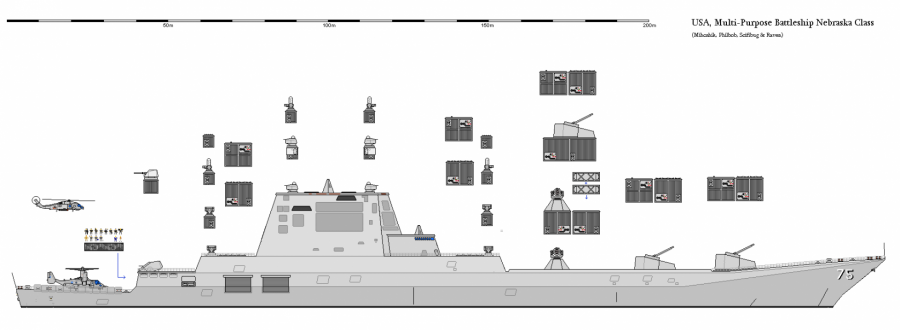
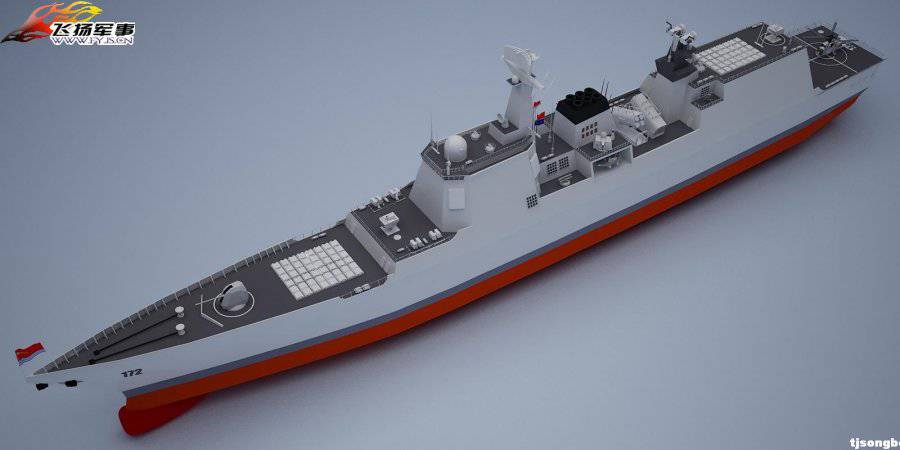
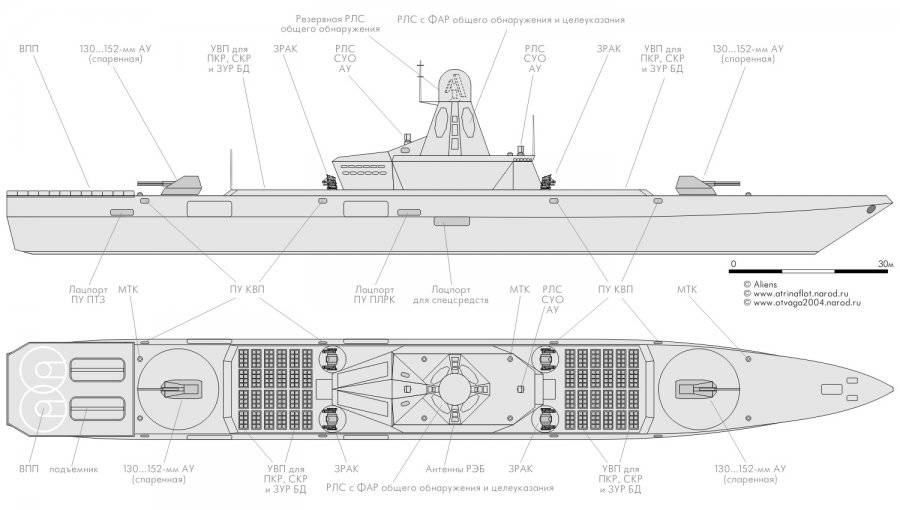

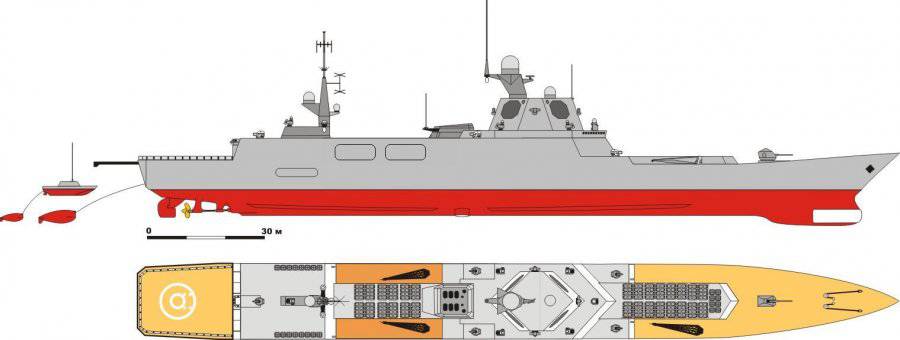

Information